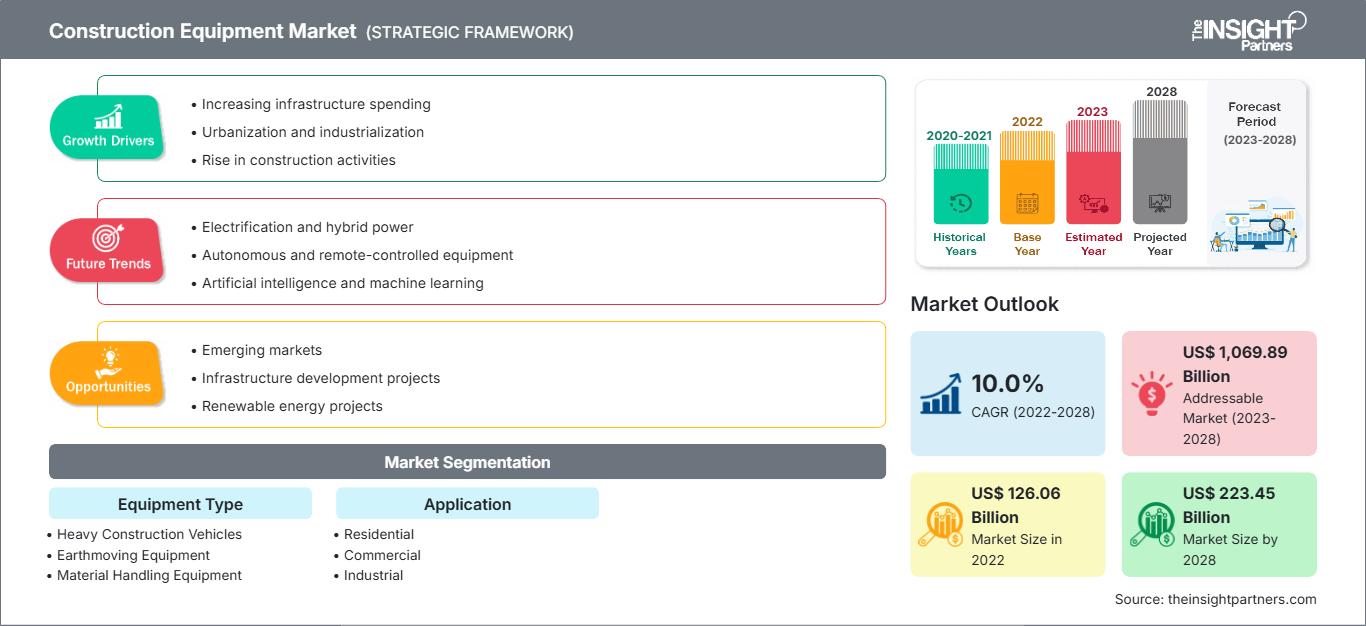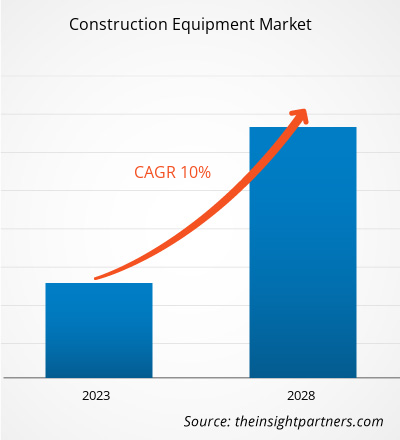건설 장비 시장은 2022년 1,260억 6,280만 달러에서 2028년 2,234억 5,110만 달러로 성장할 것으로 예상되며, 2022년부터 2028년까지 연평균 성장률(CAGR) 10.0%로 성장할 것으로 예상됩니다.
건설 작업, 특히 토목 공사를 수행하기 위해 특별히 개발된 대형 차량을 건설 장비라고 합니다. 적합한 장비를 적절히 사용하면 프로젝트의 경제성, 품질, 안전성, 속도 및 적시성을 높일 수 있습니다. 계약자가 프로젝트에 필요한 모든 건설 장비를 보유하는 것이 항상 바람직하거나 실현 가능한 것은 아닙니다. 굴착, 흙 파기, 장거리 이동, 배치, 다짐, 평탄화, 도징, 정지, 운반은 모든 건설 프로젝트의 주요 공정 중 일부입니다. 굴착 및 지반 이동과 같은 다양한 굴착 작업은 토공 장비로 수행됩니다. 토공 장비는 다양한 모양과 크기로 제공되며, 주로 수리, 건설, 고가 공사, 농업 및 철거 작업에 사용됩니다. 굴삭기는 버킷, 암, 회전식 캐빈, 이동식 트랙을 갖춘 토공 기계입니다. 백호(리어 액터 또는 백 디거라고도 함)는 두 부분으로 구성된 관절형 암 끝에 굴착 버킷이 부착된 굴착 장비의 일종입니다. 로더는 아스팔트, 철거 폐기물, 흙, 눈, 사료, 자갈, 통나무, 원광석, 재활용 자재, 암석, 모래, 나무 조각 등의 자재를 다른 유형의 기계로 옮기거나 적재하는 건설 기계입니다.
이 보고서의 일부, 국가 수준 분석, Excel 데이터 팩을 포함하여 모든 보고서에 대한 사용자 정의를 무료로 받을 수 있을 뿐만 아니라 스타트업 및 대학을 위한 훌륭한 제안 및 할인을 이용할 수 있습니다
건설 장비 시장: 전략적 통찰력

-
이 보고서의 주요 주요 시장 동향을 확인하세요.이 무료 샘플에는 시장 동향부터 추정 및 예측에 이르기까지 데이터 분석이 포함됩니다.
건설 장비 시장의 주요 이해관계자는 건설 장비 원자재, 공급 측면에서 활동하는 건설 장비 제조업체, 그리고 수요 측면에서 활동하는 건설 장비 최종 사용자입니다. 최근 몇 년 동안 특히 주택 및 상업용 건설 분야에서 건설 장비 수요가 증가했으며, 이는 향후 5년간 건설 장비 시장 성장을 견인할 것으로 예상됩니다. Caterpillar, John Deere, Komatsu, Volvo, Liebherr는 주요 건설 장비 공급업체입니다. 이러한 주요 생태계 참여자 외에도 여러 산업 분야에서 기술 발전과 제품 도입을 촉진하는 데 중요한 역할을 하는 여러 주변 이해관계자가 있습니다.
COVID-19 팬데믹이 건설 장비 시장에 미치는 영향
2020년 COVID-19 팬데믹은 건설 활동을 방해했습니다. 그 결과 전 세계적으로 건설 장비 판매가 감소했습니다. 사회 기반 시설 투자, 주택, 상업 및 산업 건설, 지하 및 유정 건설, 그리고 기관 지출은 건설 장비 제조업체에 영향을 미칩니다. 미국, 영국, 중국, 인도는 불균형적으로 큰 영향을 받은 국가들 중 일부입니다. 국제 건설 그룹(International Construction Group)에 따르면, 2020년 전체 프로젝트의 4분의 1 이상(22.7%)의 납품이 250일 이상 지연되었고, 전체 프로젝트의 10분의 1 이상(13.4%)은 1년 이상 지연되었습니다. 그러나 병원 및 기타 의료 시설, 실험실, 해운 및 물류 인프라 프로젝트는 공급이 제한적입니다. 더욱이 여러 국가에서 건설 산업을 포함한 다양한 산업 활동을 점진적으로 재개하기 시작했습니다. 인도와 중국은 산업 및 상업 건설 프로젝트를 시작했습니다. 2021년 4월, 여러 국가가 새로운 프로젝트를 시행하기 시작하면서 산업 생산량은 2021년 1월 이후 처음으로 증가했습니다. 따라서 굴삭기, 백호로더, 콤팩터, 불도저 및 기타 건설 장비에 대한 수요가 급증했습니다.
시장 분석: COVID-19 팬데믹 이후 인프라 투자 증가
COVID-19 팬데믹으로 인해 전 세계 경제 활동이 상당히 위축되었습니다. 2020-21년 동안 인프라에 대한 막대한 투자가 이루어졌으며, 이는 인프라 산업 성장에 활력을 불어넣었습니다. 발전, 국도 건설, 철도 및 해상 화물 부문의 인프라 투자는 건설 장비 수요를 견인합니다. 신흥 경제국에서는 석탄, 원유, 철강, 시멘트를 포함한 몇몇 핵심 인프라 산업이 2021년에 성장률을 보였습니다. 이러한 요인들은 건설 장비 시장 성장에 긍정적인 영향을 미쳤습니다. 인프라 투자는 제품 개발에 장기적인 영향을 미치며, 장기적으로 GDP를 증가시킬 수 있지만, 그 효과는 아직 알려지지 않았습니다. 대부분의 국가, 특히 중동 국가들은 해당 지역의 인프라 개발 프로젝트에 집중하기 위해 4자 경제 포럼을 설립했습니다. 직원 및 소비자 간 소통을 원활하게 하기 위해 기업은 디지털 솔루션과 채널을 활용하고 있습니다. 정부와 교육 기관도 이러한 방식을 활용하고 있습니다.
장비 유형 부문 분석
작업 완료를 위해 대형 공구와 기계가 필요한 상업, 주거 및 산업 프로젝트가 증가함에 따라 그 어느 때보다 많은 건설 장비가 사용되고 있습니다. 대규모 프로젝트에서는 다양한 작업에 대형 건설 장비가 사용됩니다. 중장비 유형 선택은 프로젝트의 범위와 비용을 기반으로 합니다. 이러한 요소들은 건설 과정을 용이하게 하고 속도를 높여줍니다. 굴삭기는 건설 부문에서 필수적이고 자주 사용되는 장비입니다.
응용 분야 분석
건설 장비 시장은 용도에 따라 주거, 상업 및 산업으로 구분됩니다. 아스팔트 믹싱 플랜트라고 하는 건설 장비는 도로 건설 프로젝트에 사용되는 코팅된 도로석 및 기타 유형의 아스팔트 콘크리트를 생산하는 데 사용됩니다. 도로 롤러는 기본적으로 도로와 기초를 건설하는 동안 흙, 자갈, 콘크리트 또는 아스팔트를 밀어내는 압축기 스타일의 엔지니어링 기계입니다. 깊은 기초가 필요한 고층 빌딩과 기타 거대한 산업 단지에 프리캐스트 파일을 설치할 때 파일 보링 머신을 사용하여 건설 현장에 수직 구멍을 만들어 건설 장비 시장이 성장합니다. 건설 장비 시장 참여자는 경쟁사와 경쟁하기 위해 고급 기술과 기능을 통합하여 새로운 제품 혁신과 개발에 집중합니다. 2022년 6월, Caterpillar Inc.는 전 세계 본사를 일리노이주 디어필드에서 텍사스주 어빙에 있는 회사의 기존 시설로 이전할 것이라고 발표했습니다. 이 회사는 2022년에 본사를 어빙으로 이전하기 시작할 것입니다. 장비 유형에 따라 건설 장비 시장은 중장비 건설 차량, 토목 장비, 자재 취급 장비 등으로 세분화됩니다. 적용 분야에 따라 시장은 주거용, 상업용 및 산업용으로 세분화됩니다. 지역에 따라 글로벌 건설 장비 시장은 북미, 유럽, 아시아 태평양, 중동 및 기타로 세분화됩니다. 아프리카 및 남미.
건설 장비 시장The Insight Partners의 분석가들은 예측 기간 동안 건설 장비 시장에 영향을 미치는 지역별 동향과 요인들을 면밀히 분석했습니다. 이 섹션에서는 북미, 유럽, 아시아 태평양, 중동 및 아프리카, 그리고 중남미 지역의 건설 장비 시장 부문 및 지역별 현황도 살펴봅니다.
건설 장비 시장 보고서 범위
| 보고서 속성 | 세부 |
|---|---|
| 시장 규모 2022 | US$ 126.06 Billion |
| 시장규모별 2028 | US$ 223.45 Billion |
| 글로벌 CAGR (2022 - 2028) | 10.0% |
| 이전 데이터 | 2020-2021 |
| 예측 기간 | 2023-2028 |
| 다루는 세그먼트 |
By 장비 유형
|
| 포함된 지역 및 국가 |
북미
|
| 시장 선도 기업 및 주요 회사 프로필 |
|
건설 장비 시장 참여자 밀도: 비즈니스 역학에 미치는 영향 이해
건설 장비 시장은 소비자 선호도 변화, 기술 발전, 그리고 제품 이점에 대한 인식 제고 등의 요인으로 인한 최종 사용자 수요 증가에 힘입어 빠르게 성장하고 있습니다. 수요가 증가함에 따라 기업들은 제품 라인업을 확장하고, 소비자 니즈를 충족하기 위한 혁신을 추진하며, 새로운 트렌드를 적극 활용하고 있으며, 이는 시장 성장을 더욱 가속화하고 있습니다.

- 을 얻으세요 건설 장비 시장 주요 주요 플레이어 개요
건설 장비 시장 - 회사 프로필
- Caterpillar Inc.
- CNH Industrial NV
- Hitachi Construction Machinery Co., Ltd
- JC Bamford Excavators Ltd.
- Deere & Company
- Komatsu Ltd.
- Liebherr-International Deutschland GmbH
- Terex Corporation
- Volvo CE
- Zoomlion Heavy Industry Science and Technology Co., Ltd.
- 과거 분석(2년), 기준 연도, CAGR을 포함한 예측(7년)
- PEST 및 SWOT 분석
- 시장 규모 가치/거래량 - 글로벌, 지역, 국가
- 산업 및 경쟁 환경
- Excel 데이터세트
최근 보고서
사용 후기
구매 이유
- 정보에 기반한 의사 결정
- 시장 역학 이해
- 경쟁 분석
- 고객 인사이트
- 시장 예측
- 위험 완화
- 전략 기획
- 투자 타당성 분석
- 신흥 시장 파악
- 마케팅 전략 강화
- 운영 효율성 향상
- 규제 동향에 발맞춰 대응






















 무료 샘플 받기 - 건설 장비 시장
무료 샘플 받기 - 건설 장비 시장